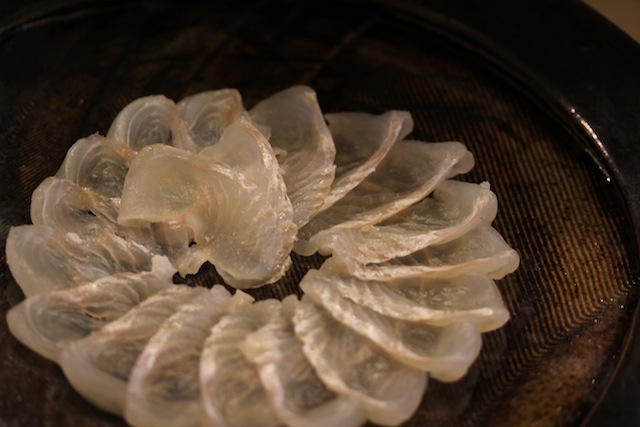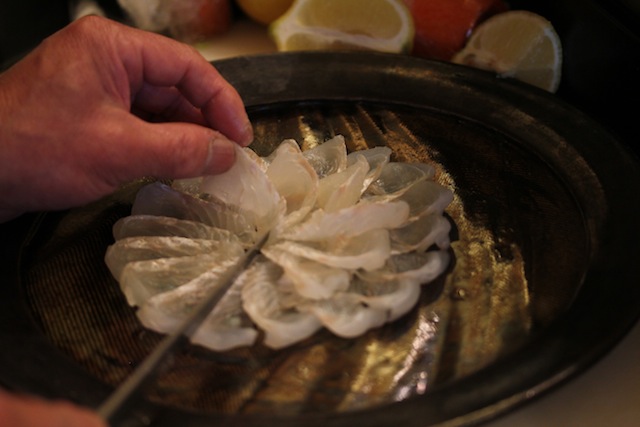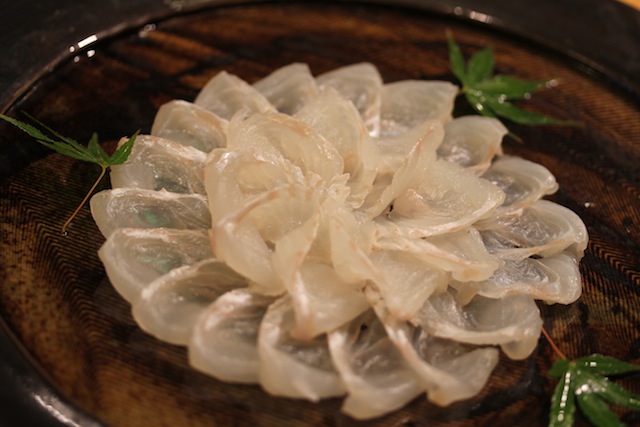 Uzuzukuri
Uzuzukuri is one of my favorite preprations of sashimi. Kuni (my dad) would make this for very special occasions growing up, usually New Year's Day or Thanksgiving. It is so gorgeous that you almost feel bad eating it. But not that bad.
The word
usuzukuri derives from 薄い (usui, or thin), meaning fish that is sliced thinly. In this country
usuzukuri is usually made with
hirame (halibut), whereas in Japan, Kuni says hirame is too expensive so they usually use
fugu (blowfish).

I always enjoy watching Kuni prepare
hirame no usuzukuri, which he'll make at Sushi Kuni if you ask (and if he has enough hirame). It is an awe-inspiring moment to watch him slice the fish so thinly -- it's very focused and precise.

Kuni says that the importance of slicing the fish so thin is to emphasize its translucence -- which is why
usuzukuri calls for some kind of white fish. Also, Kuni says that usually white fish is best sliced thin -- the meat has a nice
hagotai (bounciness) that is pronounced when cut this way. He says that the flesh of white fish (
hirame,
fugu,
tai, etc.) loses that texture when it is cut thick. On the contrary, there are certain fish that are better when it is
atsu-giri (thick-cut), like
maguro,
tako (octopus) or
mirugai (giant clam or geoduck).

Plating, of course, is also of utmost importance. For this dish, he arranges the
hirame in a chrysanthemum pattern.

So thin!

Kuni says that the actual plate itself plays a major role for the
usuzukuri. For this, people use their most opulent, large plates, usually with some sort of design or color. This way the actual plate is pronounced and can be seen through the translucent slices of fish.



Garnished with some
momiji leaves from the house.


Dip in some ponzu and enjoy.

Thanks Kuni!
*Photos by Johnny Lopes.
*Sushi Kuni is located at 10211 S. DeAnza Blvd in Cupertino. Call a day in advanced if you would like hirame no usuzukuri at 408-257-5864.
 Uzuzukuri is one of my favorite preprations of sashimi. Kuni (my dad) would make this for very special occasions growing up, usually New Year's Day or Thanksgiving. It is so gorgeous that you almost feel bad eating it. But not that bad.
The word usuzukuri derives from 薄い (usui, or thin), meaning fish that is sliced thinly. In this country usuzukuri is usually made with hirame (halibut), whereas in Japan, Kuni says hirame is too expensive so they usually use fugu (blowfish).
Uzuzukuri is one of my favorite preprations of sashimi. Kuni (my dad) would make this for very special occasions growing up, usually New Year's Day or Thanksgiving. It is so gorgeous that you almost feel bad eating it. But not that bad.
The word usuzukuri derives from 薄い (usui, or thin), meaning fish that is sliced thinly. In this country usuzukuri is usually made with hirame (halibut), whereas in Japan, Kuni says hirame is too expensive so they usually use fugu (blowfish).
 I always enjoy watching Kuni prepare hirame no usuzukuri, which he'll make at Sushi Kuni if you ask (and if he has enough hirame). It is an awe-inspiring moment to watch him slice the fish so thinly -- it's very focused and precise.
I always enjoy watching Kuni prepare hirame no usuzukuri, which he'll make at Sushi Kuni if you ask (and if he has enough hirame). It is an awe-inspiring moment to watch him slice the fish so thinly -- it's very focused and precise.
 Kuni says that the importance of slicing the fish so thin is to emphasize its translucence -- which is why usuzukuri calls for some kind of white fish. Also, Kuni says that usually white fish is best sliced thin -- the meat has a nice hagotai (bounciness) that is pronounced when cut this way. He says that the flesh of white fish (hirame, fugu, tai, etc.) loses that texture when it is cut thick. On the contrary, there are certain fish that are better when it is atsu-giri (thick-cut), like maguro, tako (octopus) or mirugai (giant clam or geoduck).
Kuni says that the importance of slicing the fish so thin is to emphasize its translucence -- which is why usuzukuri calls for some kind of white fish. Also, Kuni says that usually white fish is best sliced thin -- the meat has a nice hagotai (bounciness) that is pronounced when cut this way. He says that the flesh of white fish (hirame, fugu, tai, etc.) loses that texture when it is cut thick. On the contrary, there are certain fish that are better when it is atsu-giri (thick-cut), like maguro, tako (octopus) or mirugai (giant clam or geoduck).
 Plating, of course, is also of utmost importance. For this dish, he arranges the hirame in a chrysanthemum pattern.
Plating, of course, is also of utmost importance. For this dish, he arranges the hirame in a chrysanthemum pattern.
 So thin!
So thin!
 Kuni says that the actual plate itself plays a major role for the usuzukuri. For this, people use their most opulent, large plates, usually with some sort of design or color. This way the actual plate is pronounced and can be seen through the translucent slices of fish.
Kuni says that the actual plate itself plays a major role for the usuzukuri. For this, people use their most opulent, large plates, usually with some sort of design or color. This way the actual plate is pronounced and can be seen through the translucent slices of fish.


 Garnished with some momiji leaves from the house.
Garnished with some momiji leaves from the house.

 Dip in some ponzu and enjoy.
Dip in some ponzu and enjoy.
 Thanks Kuni!
*Photos by Johnny Lopes.
*Sushi Kuni is located at 10211 S. DeAnza Blvd in Cupertino. Call a day in advanced if you would like hirame no usuzukuri at 408-257-5864.
Thanks Kuni!
*Photos by Johnny Lopes.
*Sushi Kuni is located at 10211 S. DeAnza Blvd in Cupertino. Call a day in advanced if you would like hirame no usuzukuri at 408-257-5864.




Comments (2)
That is beautiful. I never realised it’s a chrysanthemum design. My favourite sashimi is white fish precisely because of the hagotae!
Kuni is an artist, behind or in front of the counter. That dinner was amazing!